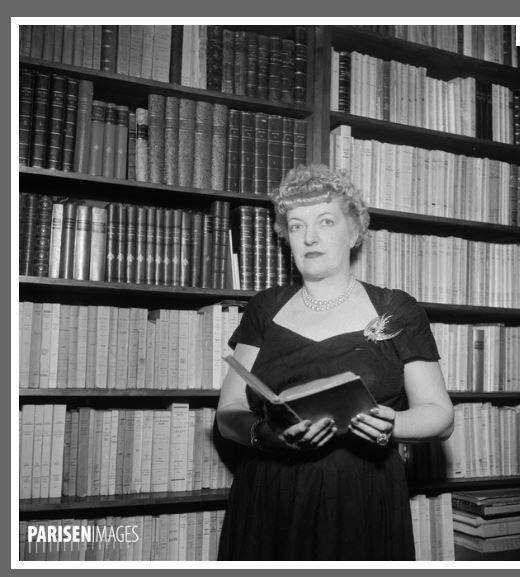Nationality French Name Yanette Deletang-Tardif Role Author | Years active 1929–1963 Died 1976, Paris, France Partner Raymond Tardif | |
 | ||
Born Anne Marie Paule Deletang18 June 1902Roubaix, France ( 1902-06-18 ) Occupation Poetess, translator, painter, illustrator Notable awards Mallarme prize (1942)Renee Vivien prize (1962) | ||
Literary movement Rochefort school | ||
Yanette Delétang-Tardif (Roubaix, 18 June 1902 – Paris, 1976) was a French poet, translator into French of Spanish and German works, painter and illustrator. She was a very productive and reputed author of poetry, however she appeared sometimes as a restricted poetess.
Contents
Biography
Yanette Delétang-Tardif, born Anne Marie Paule Delétang, was the daughter of Marie Troupeau and Maurice Delétang, an industrialist. She was the widow of Raymond Tardif, by whom she had a son called Jean-Loup.
After her marriage, she took her pen-name: Yanette Delétang-Tardif. Then she had been succeeding to establish herself as a fully-fledged writer with the publishing of her first collections of poems: Éclats in 1929, Générer, a poetic work about her motherhood experience, in 1930 and Vol d'oiseaux in 1931. Those early works testify to the sway of Paul Valéry's rhythmic pattern. In her book Confidences des îles written in 1934, she adopted a style revealing the adding influence of Guy Lavaud. Meantime, she published in several periodicals, ranked as a recognized poet. In 1935, the monthly L'Année poétique brought out a special issue devoted entirely to her, in which she had her portrait done by Jean de Bosschère. Inquisitive about surrealism as a cultural movement, she was little inclined to its ideological side.
As a poet, she had joined the École de Rochefort, inside which she was the only woman, since the poet Jean Bouhier created this poetic movement in 1941. Even though she had so become a founding member of that talented group of poets, she remained free and defended personal conceptions of poetry, such as the benevolent welcome of Stéphane Mallarmé's poems, very dissimilar from the Rochefort group's poetic ideal. In 1942 she won the Mallarmé prize to honour her work and bring out her book Tenter de vivre. At that time she also met Jean Cocteau with whom she became well acquainted. At her particular request then, Jean Cocteau drew her portrait, once reproduced in his war journal and made a second time in 1943. Like the accomplished artist she admired, she formed a passion for circus about which she wrote articles.
Some surrealists distributed a leaflet at the end of 1942–1943 wintertime in which they mocked her poetical works through her interest for circus arts and aimed to condemn who they considered as collaborationist artists. Thus, among several authors, they put a stress on the single contribution to La Nouvelle Revue Française made by Yanette Delétang-Tardif regarding the period when the quarterly magazine was caught up in the collaboration movement. Despite the vigorous libel actions of those surrealists, she was not banned as an undesirable writer by the Comité National des Ecrivains after the Liberation and, therefore, never prosecuted for collaborationism.
She kept up a correspondence with Max Jacob, who was a well-known figure among the most representative fellows of the Rochefort poetic movement. Then, following his death in 1944, she was the first one to transcribe the most extensive story from witness statements of the martyrdom of the Jewish poet, and proved to be an investigative writer.
At that time, Gérard de Nerval's sonnets Les Chimères and German poets of the romantic era belonged to her beloved literatures, which had played a part in the development of her works. She was especially interested in Johann Wolfgang von Goethe, of whom she gave a renowned French translation of the poems — together with Maurice Betz — in 1946. In 1949 she collaborated with Paul Arnold on the French translation of Friedrich Nietzsche's complete poetical works. Although never published in her lifetime, she also created a really fine translation of Nachtwachen von Bonaventura, reflecting her interest in romanticism through a masterpiece of German literature.
Delétang-Tardif's writing was not confined to poetry nor translated works and, following her taste, she wrote novels and completed critical works.
The year 1950 marked her author career when she was awarded the recipient of the Renée Vivien prize for her poetry collection Sept chants royaux.
From the outset of her career, her nom de plume referred to her husband's family name, which she attached to her father's name. When he died she was plunged into despair. Then, in 1963 she cut off from the literary world of Paris.
She died in relative obscurity in 1976 at Paris.
